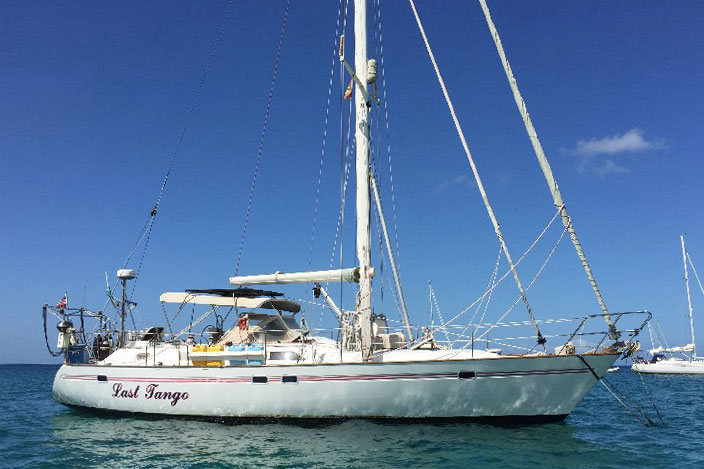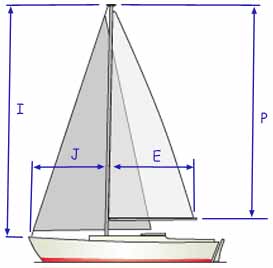- Home
- Cruising Yachts 40' to 45'
- Taswell 43 Specs
The Taswell 43
Specs & Key Performance Indicators
The Taswell 43 sailboat, designed by British naval architect Bill Dixon, is a cutter-rigged vessel constructed with a fiberglass hull. The boat was built by Ta Shing Yacht Building Ltd, located in Tainan, Taiwan.
 The Taswell 43 Cutter
The Taswell 43 CutterPublished Specification for the Taswell 43
Keel & Rudder Configuration: Fin keel with rudder on skeg
Hull Material: Fiberglass
Length Overall: 13.1m (42'10")
Waterline Length: 11.7m (38'3")
Beam: 4.2m (13'8")
Draft: 1.9m (6'3")
Rig Type: Cutter
Displacement: 10,659 kilograms (23,500 pounds)
Ballast: 4,354 kilograms (9,600 pounds)
Water Tank Capacity: 727 litres (192 US gallons)
Fuel Tank Capacity: 326 litres (86 US gallons)
Hull Speed: 8.29 knots
Designer: Bill Dixon
Builder: Ta Shing Yacht Building Ltd.
Year First Built: 1987
Year Last Built: Not specified
Number Built: Not specified
Options & Alternatives
Buyers of the Taswell 43 sailboat had several design options to choose from:
- Draft: The Taswell 43 had draft options ranging from 1.91m (6'3") to 2.01m (6'7").
- Interior Layouts: There were multiple interior layout options available. Common configurations included an aft owner's suite with an island berth and a private head with a stall shower, as well as a forward stateroom with a private head and stall shower. Some layouts also featured additional cabins with bunk beds and a second bathroom in the bow.
A later version was produced known as the Taswell 43 All Season. This version featured a raised saloon and pilothouse, providing better visibility and protection from the elements, making it more suitable for all-weather sailing.
Sail Areas & Rig Dimensions
I: 16.8 meters (55'0")
J: 5.2 meters (17'0")
P: 14.9 meters (49'0")
E: 4.9 meters (16'0")
Total Sail Area: 79.9m2 (860ft2)
Mainsail Area: 36.4m2 (392ft2)
Foresail Area: 43.4m2 (467.5ft2)
Published Design Ratios
The Key Performance Indicators (KPIs)
The published design ratios for the Taswell 43 sailboat are as follows:
- Sail Area to Displacement Ratio (SA/D): 16.8
- Ballast to Displacement Ratio (B/D): 40.9%
- Displacement to Length Ratio (D/L): 187
- Comfort Ratio: 27.9
- Capsize Screening Formula: 1.91
Based on these published design ratios, the theoretical performance characteristics of the Taswell 43 are:
- With an Sail Area to Displacement Ratio (SA/D) ratio of 16.8, the Taswell 43 falls within the range of 16 to 20, indicating reasonably good performance. This suggests that the boat has enough sail power to perform well in various wind conditions, suitable for both cruising and recreational sailing.
- A Ballast to Displacement Ratio (B/D) of 40.9% indicates a stiff and powerful boat that can stand up well to the wind. This level of ballast provides good stability, making the Taswell 43 a reliable platform in stronger winds and heavier seas, contributing to its seaworthiness and safety.
- The Displacement to Length Ratio (D/L) of 187 categorizes the Taswell 43 as a light displacement boat (100-200). Light displacement boats are generally quicker, more responsive, and require less sail area to reach their design hull speed. This points to the Taswell 43 being efficient and relatively fast, enhancing its performance in various sailing conditions.
- With a Comfort Ratio of 27.9, the Taswell 43 is described as having a motion associated with a coastal cruiser with moderate stability. While it may not be the most comfortable boat in extreme conditions, for typical coastal cruising and the occasional longer passage, it should provide a pleasant and manageable motion for the crew.
- The Capsize Screening Formula result of 1.91 is below the threshold of 2.0, indicating that the Taswell 43 is suitable for ocean passages and has good blue water capability. This suggests that the boat is designed to handle offshore conditions and can be considered relatively safe for extended voyages.
Summary:
Overall, the Taswell 43 is a versatile sailboat well-suited for both coastal cruising and offshore adventures, with balanced design parameters that offer a good compromise between performance, comfort, and safety.
Here's how to calculate the KPIs yourself - without having to wrestle with the mathematics...
Design Ratios: Notes of Caution...
- The Sail Area/Displacement Ratio (SA/D): This ratio provides an estimate of the sail power relative to the boat's weight, which can indicate potential speed in various wind conditions. But it doesn't account for the efficiency of the sail plan, the rigging, or the skill of the crew. Real-world performance can vary significantly based on these factors.
- The Ballast/Displacement Ratio (B/D): This ratio gives an idea of the boat's stability and stiffness, which is crucial for handling and safety. But it doesn't consider the distribution of the ballast or the hull shape, both of which can greatly affect stability. A high B/D ratio alone doesn't guarantee a stable boat if the ballast is poorly distributed.
- The Displacement/Length Ratio (D/L): This ratio helps predict the boat's speed potential and its behaviour in different sea conditions. But it doesn't account for the hull design or the boat's overall weight distribution. Two boats with the same D/L ratio can perform very differently if their hull shapes are different.
- The Comfort Ratio (CR): This ratio estimates the boat's motion comfort in a seaway, which is important for long passages. But it doesn't consider the boat's interior layout, which can also affect comfort. Additionally, personal tolerance to motion varies, so a boat that is comfortable for one person might not be for another.
- The Capsize Screening Formula (CSF): This formula assesses the likelihood of a boat capsizing in heavy seas, which is critical for offshore safety. But it doesn't take into account the boat's handling characteristics or the skill of the crew. A boat with a low CSF can still capsize if poorly handled in severe conditions.
General Limitations
- Static Nature: These ratios are static measurements and don't account for dynamic factors like wave action, wind gusts, or crew actions.
- Simplification: They simplify complex interactions into single numbers, which can be misleading. Real-world performance is influenced by a multitude of factors that these ratios can't fully capture.
- Context: The context in which the boat is used (e.g., coastal cruising vs. offshore racing) can greatly affect how these ratios should be interpreted.
In summary, while these ratios provide valuable insights into the theoretical performance characteristics of a sailboat, they should be used as part of a broader assessment that includes practical experience, sea trials, and expert advice.
This article was written with the assistance of Gemini, a large language model developed by Google. Gemini was used to gather information, summarize research findings, and provide suggestions for the content and structure of the article.
Recent Articles
-
Is Marine SSB Still Used?
Apr 15, 25 02:05 PM
You'll find the answer to this and other marine SSB-related questions right here... -
Is An SSB Marine Radio Installation Worth Having on Your Sailboat?
Apr 14, 25 02:31 PM
SSB marine radio is expensive to buy and install, but remains the bluewater sailors' favourite means of long-range communication, and here's why -
Correct VHF Radio Procedure: Your Questions Answered
Apr 14, 25 08:37 AM
Got a question about correct VHF radio procedure? Odds are you'll find your answer here...













